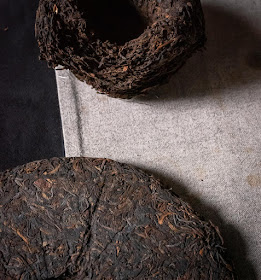Aged sheng puerh is the Holy Grail of gongfu cha drinkers. As prices of cakes from the 1970s reach 20,000 to 30,000 USD, they have become the dream of all the serious puerh drinkers. And for this class, I have prepared some sheng leaves from the 70s to show my student what such tea is all about.
But before that, I wish to show the difference between a real aged sheng and a well made imitation. So, we compare these 2 teas: a 1999 and a 1985 sheng.
Can you spot which of the 2 was actually made in the 2000s and is faking its age?
We use gaiwans to brew the 2 teas. And 2 sets of ivory porcelain cups. The color difference is more obvious in the singing cups, but the flower cups are more suitable for the cold weather. Here, the answer is much more obvious, but only if you know that one is a fake.
 |
| First brew |
Maybe you wish to have a look at the spent leaves to identify them:
 |
| 1985 |
 |
| 1999 |
 |
| Below and cup: 1985 loose sheng puerh. Above: 1970s puerh. |
 |
| 1970s sheng puerh |
The other advantage of the clay teapot over the porcelain gaiwan is that it keeps the brew at a higher temperature on a cold day. This means a better extraction of flavors.
I can't start to explain the pleasure we enjoyed with this 40 + years old puerh. Antonio said that this is a tea that makes you meditate. It overwhelms you with its peaceful force and brings quiet to your mind.
The color of that second brew in the flower cup above is very dark. In the singing cup below, it seems to shine. What a beautiful tea! No wonder it has become a holy grail for which rich Chinese are willing to spend a lot of money despite the risk of getting a fake! The most common way they make sure is that their puerh tea is old is by trusting the packaging. An old wrapper gives the customer a certain reassurance about the age of the tea. However, it's relatively easy to forge a wrapper and I don't recommend trusting the packaging. The best is to learn how aged puerh taste and then trust your own taste to recognize genuine aged from faked leaves!
This tea feels like Christmas!









To Anybody passing by Taiwan I highly recommend contacting Stéphane! Trying these pieces of history and learning about them is such a pleasure.
ReplyDelete